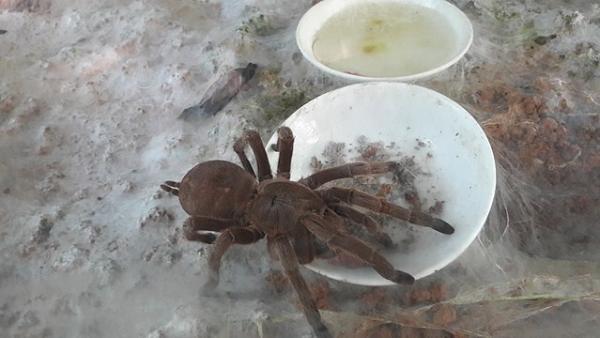Pain management remains a national issue entangled and exacerbated by the simple fact that our available pain medications have significant side effects, from constipation to addiction. Lost in the national conversation is that pain is a signal from our nervous system of danger and damage. Pain is sensory information transmitted by our nerves. The transmission of pain signals is controlled by sodium gates that provide the spark for the nerve’s electrical signal. Nav1.7 is a gate of particular interest.
There are reports that humans, who cannot feel pain (which by the way is quite a debilitating condition) have no Nav1.7 channels. Inhibition of NaV1.7 suppresses pain perception. What if there was a way to control these gates to suppress chronic pain selectively? A study in Nature Biomedical Engineering provides a fascinating look at how, at least in a mouse model, these gates can be manipulated.
The story begins with a tarantula, specifically the Chinese bird spider, Haplopelma schmidti, which produces a natural analgesic peptide, Huwentoxin-IV (HWTx-IV). This peptide selectively inhibits NaV1.7, without interfering with other sodium gates. More importantly, injection of this peptide results in suppression of pain. Unfortunately, the peptide’s bioavailability, how much is effectively absorbed and can be used, is low requiring multiple high dose injections.
The researchers first develop an in vitro test to measure the effect of various agents on NaV1.7 gates. HWTx-IV closed them down pretty effectively. Other blocking compounds, specifically lidocaine, tetracaine (two local anesthetics) and amitriptyline, a medication often prescribed for neuropathic pain did not shut these sodium gates as effectively; aspirin had no substantial effect.
To increase HWTx-IV’s bioavailability the researchers, modified its structure creating a designer molecule produced and secreted by altered human cells. Using their in vitro test they demonstrated the efficacy of their designer molecules in closing the NaV1.7 gates. The researchers moved on to their in vivo model, mice. Injecting formalin into their footpads evokes excessive licking and biting of the paw within a few minutes of injection – the mouse measure of pain. The mice implanted with micro-encapsulated human cells producing the designer form of HWTx-IV “exhibited substantially reduced chronic pain behavior compared with controls.” They had demonstrated both that designer HWTx-IV worked and that the cells produced sufficient quantities to relieve pain.
Controlling the newly designed cells
A constant infusion of HWTx-IV would leave you insensate, without any pain, including the protective pain we need. Episodic pain relief would be impractical requiring cell placement every time you needed pain relief. To solve this problem, the researchers created a biochemical remote control on demand system. They “rewired” a mouse olfactory receptor cell to respond to R-carvone. - a volatile chemical conferring spearmint’s characteristic odor. This olfactory off-on switch was then linked to release designer HWTx-IV. The entire setup, HWTx-IV production, and the R-carvone remote control were packaged into what they termed an AromaCell.
Mice were then exposed to R-carvone through oral intake or an aroma diffuser. Mice with implanted AromaCells demonstrated significant pain relief, as measured by their behavior, compared to controls without the implant. The effect could repeatedly be triggered for three weeks or more without apparent side effects. In a study using a neuropathic pain model, mice with these AromaCells, exposed to 24 hours of spearmint therapy evidenced suppression of pain for over nine days as compared to six hours with tramadol. When a narcotic antagonist, naloxone (Narcan), was injected the mice with AromaCells showed no evidence of withdrawal. Mice treated with Tramadol or morphine for the same pain did show withdrawal symptoms. [1]
Here is the bottom line. These scientists, really bioengineers, created human cells that provide on-demand, apparently potent and efficacious pain relief. There may well be additional benefits in reducing pain medicine's addictive nature. It is an excellent proof of concept study and points at a new avenue in the treatment of persistent neuropathic and chronic inflammatory pain. It is a reminder of the innovative, thoughtful work of scientists in addressing real-world problems and improving our lives.
[1] Withdrawl was measured by jumpiness and agitation after receiving the naloxone injections.
Source Treatment of Chronic Pain by Designer Cells controlled by spearmint aromatherapy Nature Biomedical Engineering DOI:10.1038/s41551-018-0192-3




